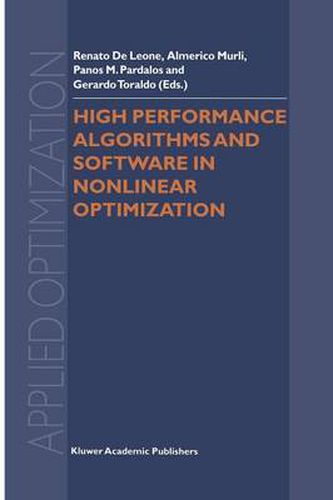Readings Newsletter
Become a Readings Member to make your shopping experience even easier.
Sign in or sign up for free!
You’re not far away from qualifying for FREE standard shipping within Australia
You’ve qualified for FREE standard shipping within Australia
The cart is loading…






This title is printed to order. This book may have been self-published. If so, we cannot guarantee the quality of the content. In the main most books will have gone through the editing process however some may not. We therefore suggest that you be aware of this before ordering this book. If in doubt check either the author or publisher’s details as we are unable to accept any returns unless they are faulty. Please contact us if you have any questions.
This book contains a selection of papers presented at the conference on High Performance Software for Nonlinear Optimization (HPSN097) which was held in Ischia, Italy, in June 1997. The rapid progress of computer technologies, including new parallel architec tures, has stimulated a large amount of research devoted to building software environments and defining algorithms able to fully exploit this new computa tional power. In some sense, numerical analysis has to conform itself to the new tools. The impact of parallel computing in nonlinear optimization, which had a slow start at the beginning, seems now to increase at a fast rate, and it is reasonable to expect an even greater acceleration in the future. As with the first HPSNO conference, the goal of the HPSN097 conference was to supply a broad overview of the more recent developments and trends in nonlinear optimization, emphasizing the algorithmic and high performance software aspects. Bringing together new computational methodologies with theoretical ad vances and new computer technologies is an exciting challenge that involves all scientists willing to develop high performance numerical software. This book contains several important contributions from different and com plementary standpoints. Obviously, the articles in the book do not cover all the areas of the conference topic or all the most recent developments, because of the large number of new theoretical and computational ideas of the last few years.
$9.00 standard shipping within Australia
FREE standard shipping within Australia for orders over $100.00
Express & International shipping calculated at checkout
This title is printed to order. This book may have been self-published. If so, we cannot guarantee the quality of the content. In the main most books will have gone through the editing process however some may not. We therefore suggest that you be aware of this before ordering this book. If in doubt check either the author or publisher’s details as we are unable to accept any returns unless they are faulty. Please contact us if you have any questions.
This book contains a selection of papers presented at the conference on High Performance Software for Nonlinear Optimization (HPSN097) which was held in Ischia, Italy, in June 1997. The rapid progress of computer technologies, including new parallel architec tures, has stimulated a large amount of research devoted to building software environments and defining algorithms able to fully exploit this new computa tional power. In some sense, numerical analysis has to conform itself to the new tools. The impact of parallel computing in nonlinear optimization, which had a slow start at the beginning, seems now to increase at a fast rate, and it is reasonable to expect an even greater acceleration in the future. As with the first HPSNO conference, the goal of the HPSN097 conference was to supply a broad overview of the more recent developments and trends in nonlinear optimization, emphasizing the algorithmic and high performance software aspects. Bringing together new computational methodologies with theoretical ad vances and new computer technologies is an exciting challenge that involves all scientists willing to develop high performance numerical software. This book contains several important contributions from different and com plementary standpoints. Obviously, the articles in the book do not cover all the areas of the conference topic or all the most recent developments, because of the large number of new theoretical and computational ideas of the last few years.